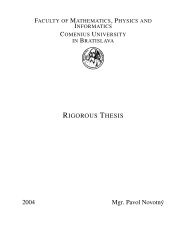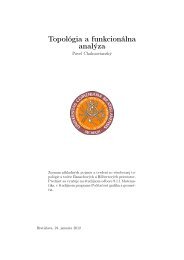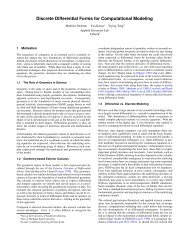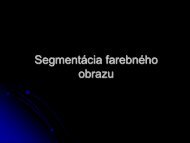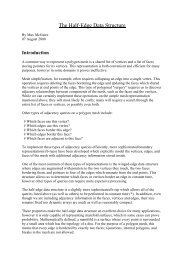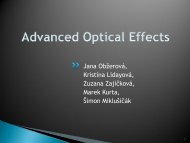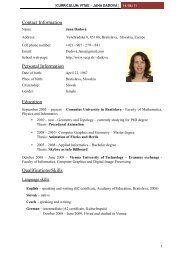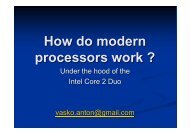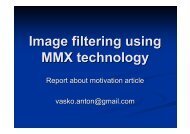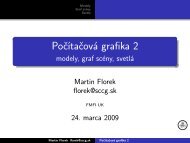Animation
Animation
Animation
You also want an ePaper? Increase the reach of your titles
YUMPU automatically turns print PDFs into web optimized ePapers that Google loves.
Computer <strong>Animation</strong> History
One of the early interests for using computer graphics for movingpictures creation.• Kenneth C. Knowlton• the first publications describing experience & methods for computermovies• 1964 the first programming language for computer animationHis animations simulated simple moving objects created frompolylines, polygons or projecting 3D polyhedra to 2D plane
History reports chronology, events, ideas, ... to provide us with theshared experience with eventual prediction power.• Chronology/Timeline at• http://www.accad.ohio-state.edu/~waynec/history/timeline.html• Books:• A. Glassner, Nadia & Daniel Thalmann, J. Vince...
• Nadia & Daniel Thalmann– Montreal University, Canada– 1981 animation system for 3D objects MIRA (MIRANIM)– important influence for animating systems– 1989, headed by Nadia Magnenat-Thalmann– research group at “University of Geneva”, SW
TRON - trailer
TRON
TRON - Light Cycles With Music Score
TRON - Love Scene
• 1983 - Lucasfilm– introduction of Particle systems– Star Trek II: The Wrath of Kahn– new effect “motion blur ”– W. Reeves “ Particle Systems -A Technique for Modelinga Class of Fuzzy Objects "• 1984 - Wavefront Technologies– the first large and marketed software: CG and CA– modeling of 3D scene– photorealistic rendering– scene objects choreographyBefore, such programs available only in research centers/universities
• John Lasseter– computer animation artist– Disney Studios -> PIXAR <strong>Animation</strong> Studios– several Academy Awards for animations– authored several short and commercial movies• 1984 - The Adventures of André and Wally B ( J. Lasseter, the firstuse of particle systems for grass )
• 1987 - Luxo Jr. ( J. Lasseter )– Nomination - Golden Nica - Ars Electronica (Linz)• 1988 - TIN TOY ( J. Lasseter )– The first Oscar for computeranimation
• 1988 - Red´s Dream ( J. Lasseter )• 1989 - Knickknack ( J. Lasseter )– alternatively created as 3D stereoscopic version
• 1991 - Beauty and the Beast ( Walt Disney Pictures )– hand drawn movie with extensive use of computer for coloring(complete animation) and 3D models, inhabited by hand drawncharacters and creatures.• 1995 - TOY STORY - (Disney, PIXAR)– J. Lasseter– THE FIRST 3D animated movie– No phasing, the complete model offairy tale reality– Golden Nica - Ars Electronica– Important milestone incinematography right in thecentenary celebrations year
History reports chronology, events, ideas, ... to provide us with theshared experience with eventual prediction power.• Chronology : http://www.accad.ohio-state.edu/~waynec/history/timeline.html• 1450 Guttenberg/press… Niepce/camera… Edison/manyinventions... Ejzenstein/film cut... Chaplin/gag… sound...stereoscopy...• Technology timeline• Art language timeline• Computer graphics timeline (authoring tools,encoding standards, compression, women, ArsElectronica… points of view)• Future: home moving theatre, interactive TV...
• 1992 - Terminator II (Industrial Light&Magic)– Academy Award for Visual efects– IMAGINA92 - Monte Carlo
• Computer animation uses:– Ads, flying logos, TV, ...– Visual effects– Feature films, many roles:1992 - Death Becomes Her1993 - Jurassic Park1994 - Flinstone, Stargate, The Mask1995 - Judge Dredd, Batman Forever,Jumanji, Casper1996 - Independence Day, Twister,Dragonheart1997 - Star Wars, Titanic1999 - Star Wars:The Phantom Menace
• 1997 - Geri´s Game - (PIXAR)– Oscar, completelycomputer animated film– Subdivision surfaces• 1998 - Bug´s Life - (Disney, PIXAR)– big commercial success
• November 1999 - TOY STORY 2 - (Disney, PIXAR)• 2000 - For the Birds (PIXAR)
• 2001 - Shrek
• 2001 - Final Fantasy ( The Spirits Within )– all characters animated, photorealism, hair for millions dollars
• November 2001 - Monsters, Inc.
Computer GraphicsFundamentals
• Analogy of photography and computer graphicsMovie orsnap/photoCameraObjectVisualperceptionDisplayRecordReal worldMonitorComputerGeometricrepresentationVisualperceptionDisplayGeometry toimage dataModel• ISO: Computer graphics: methods & techniques for construction,manipulation, storage and displaying pictures using computer.
• Picture– Graphics display created by computer graphics (known model).– Structured Non-structured (given by image points)– Natural Synthetic• Continuous image - photography, poster, painting• Digital image - matrix m x n (m-rows, n-columns)– PIXEL (Picture Element) - digital image atom– Resolution: m x n x color depth• Continuous image ----- digitization -----> Digital image(Photo ---------------> Scanner -------------> Display)• 2D Graphics - modeling in the plane• 3D Graphics - modeling in 3D space ( projection to 2D )• Picture Creation:1. Geometric modeling and object representation ( 2D or 3D)2. Defining physical properties of the object ( color, material, ... )3. Defining physical properties of the scene scény and composition of objects4. Display the scene (camera parameters, projection type, realistic or stylised -photorealism or NPR, visibility… )
<strong>Animation</strong>( Anima - spirit, soul, life... )ISO: <strong>Animation</strong>: image sequence ordered in time for videodisplay. This covers all changes which cause visual effect (position,shape, color, transparency, object structure and texture, lighting,camera parameters, even the rendering technique).
Classic (cel) animation (handmade)Script (storyboard layout)– action sketch and fabula descriptionObject definition– defining shape and properties of objects, synthetic actorsKey-frame specifications– discrete timing - draw significant framesGeneration of in-between frames– interpolating frames in time, between the keyframesChief animator (choreographer) designs and depicts objects.Phasing of the complete animation is too complex,therefore she completes the key-framing.Help animators do the phasing, coloring, etc. (in-between frames).Use of computers for work automation.
Computer animation• Computer supported animationa) computer creates primitives (polylines, polygons, ... )b) inbetweening (interpolations, morphing, warping ... )c) coloring ( area fill, texturing ... )d) visual effects (fade out, dissolve, transition, wipe … )• Computer modeled animation– Making scene objects alive - object autonomy– Display of time-dependent scene– Image generation, change object attributes and camera parametersin time– Simulation - cretaing highly realistic animation– Change any parameter ( color, size, … )
Creating Computer <strong>Animation</strong>• Storyboardssketch the storygive the message• Shadingcolors, surfaces,materials,textures• Modelling2D/3D models(e)motionspecification• Lightinglightsourcesin the scene• <strong>Animation</strong>Choreographyof motion inthe scene• Renderingtransform theimages intothe animation
Storytelling• Story, oral history• Myth (past time)• Fairy tale (two times)• Sci-fi• (past, present, future)~ SOUND SPACES~ GAGMAN• Written stories• Novel/travelling• Drama/agora• Script/street• Performed stories• Theatre• Cinema, TV• WWWStorytelling patterns: joke, folktale & Propp morphology, drama...
The First Department of Digital Storytelling...• Interactive storytelling for GUI• New artwork• For WWW and at WWW:http://www.animationlibrary.com/a-l/ - Over 13,754 free <strong>Animation</strong>s Online!• Storytelling as a profession, authoring tools at:• http://www.dramatica.com/,• http://home.click2learn.com/en/toolbook/index.asp,• http://www.macromedia.com/software/director/• http://www.macromedia.com/software/authorware/ - free demo
• The level of abstraction in motion parameters representation dividescomputer animation:– Low-level computer animation– High-level computer animation• High level operations are composed from the low level onesLow level animation• the motion is defined using parameters, which is necessary to set manually( speed, orientation, direction, speeding up, ... )• key-framing• key-parameter• animation curves– define object trajectory ( key frame interpolation )– define parameter value change– interpolating curves determine the whole of animation ( continuity, shapechanges between intepolated points, smoothness, speed changes ... )– Bézier curves,– Kochanek-Bartels (TCB),– Catmul-Rom spline ( C 2 -continuous ),– ...
High level animation• motion defined by abstract commands: collide, follow, explore, go ahead, …• ( collision detection, forward / inverse kinematics, hierarchies, structures, state space, ...)• Kinematics - study of motion independently on forces influence (location, speed, acceleration)• Dynamika - study of mutual interaction of forces and objects• Segment structure (articulated structure)• Open segment strukture - end effector• DOF-degree of freedom• State space - state vector ( v=(v 0 ,v 1 ,…,v N ) #DOF = N-1 )End effector P(x,y)• Animating the motion of segment structure is searching the path in its state space (sequentialtravelling through given states)
• Forward kinematics– hierarchy– the change of a part causes changing of all succesors– end effector position P = f ( v )– model control is not intuitive and is tedious• Inverse kinematics (goal directed motion)– inverse forward kinematics– v = f -1 ( P )– !!! 1. f -1 may not exist for particular P - underestimated2. Ideas ( approximation theory methodology, e. g. limit the state space )
• Collision detection• Virtual Reality - real time - imprecise• Computer <strong>Animation</strong> - exact computations - out of real time• Collision detection and reaction• Algorithms– Sphere hierarchy– OBB trees(Oriented Bounding Box)
Power and benefits of computer graphics and animation• NO NEED OF PHYSICALLY EXISTING MODEL (INTERIER, EXTERIER, ... )• FREE CAMERA POSITIONING IN THE SCENE• SIMULATIONS, VISUALIZATIONS AND RECONSTRUCTION OFPHENOMENA OR EVENTS• SAVES & MAKES MONEYProblems of computer graphics and animation• Realistic image– photorealism (Ray-Tracing, Radiosity)• Realistic motion– Motion Capture technology• Modeling of natural phenomena– special modeling (vegetation - Fractal Modeling, waterfalls -Stochastic Modeling)
Motion Capture Technology
• Motion Capture, MC– create realistic looking motion of complex objects and structures– Methods:• Optic sensors• Elektromagnetic field• Potenciometric approach• Combinations of the previous ones– Application areas:• Body motion capture• Facial motion• Hand and fingers motion
• Optic method– cameras– 31 markers - joints– capturing in various environments– analyse marker trajectories– absolute location
• Electromagnetic MC– electromagnetic field– markers - objects sensible to motion in the field– analyse the markers placement– relative location change
• Potentiometric method– mechanic principle
• Body motion (moving body recording )
• Facial motion ( facial mimics capture )
• Hand motion ( capturing of hands/fingers movements )
• MoTekCapturing various movements data ( in a plethora of environments )Movie industryReal-time MC
• Realistic appearance of a human– Appearance• photorealism methods• texture mapping (skin, clothes)• deformations (muscles)• material imitation and simulation– Motion• Motion Capture - complete body motion• collision detection• simulated clothes properties
• Face - 3D Model
• Face - 3D Model
• Face– realistic maps (texture map, bump map,specular map)– layered maps onto the 3D modelTexture mapBump mapSpecular map
• Wrinkles/Falten– Reality - smoothing– Here - creating– Increase believability– Location influencedby mimics ormovement– Detailising of eyesexpression
• Wrinkles– Reality - smoothing– Here - creating– Increase believability– Location influencedby mimics ormovement– Detailising of eyesexpression
• Hair– Sophisticatedtechniques• Plenty of individuals (~ 120 000)• Each individual connected to scull surface• Styles - fluid flow simulation or air blowing
• Barb– influences expression– hair/nohair– influenced by mimics– shadows casting more compex– more details
• Muscles– body movement influence– simple muscle structure– muscle deformations– mapping the skin texture
• Muscles– body movement influence– simple muscle structure– muscle deformations– mapping the skin texture
• Motion– realistic motion: Motion Capture technology– actors acting all movements for all characters in each act
• Clothes– simulation of properties– collision detection
Authoring Tools
Authoring ToolsAuthoring ToolsAuthoring ToolsVRML case:1) Modeling (3DS Max, Rhino 3D, Maya,Spazz 3D, Cosmo Worlds, trueSpace etc.)2) Manual VRML editing, recommended"VrmlPad" (ParallelGraphics), by J. Zara3) AnimateGeneral case:1) WWW, WWD, RenderMan, AutoCAD,HyperFun, Organica, VolVis, FractInt, ...freeware, dedicated software…2) Combine/AnimateAuthoring Tools
trueSpace(Caligari Corporation)www.caligari.com
Maya(Alias/Wavefront)www.aw.sgi.com
3D Studio MAX(Kinetix, Inc.)www.discreet.com
Using Maya<strong>Animation</strong>• <strong>Animation</strong> development environment• Keyframe animation• Nonlinear animation• Path <strong>Animation</strong>• Motion capture animation
<strong>Animation</strong> development environment• <strong>Animation</strong> controls• Time slider• Range slider• Playback controls• <strong>Animation</strong> controls menu• Current character settings• Editing animation preferences• Frame rate heads up display
Livecomputer animated demos...



